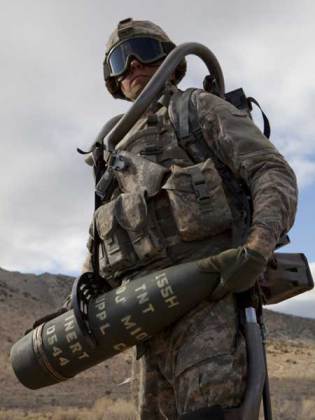Lockheed Martin HULC robotic exoskeleton will operate longer
 After writing about Japanese HAL-5 robotic exoskeleton, in this article we’re going to write about Human Universal Load Carrier (HULC) robotic exoskeleton. Developed by Lockheed Martin and Berkeley Bionics, the HULC robotic exoskeleton doesn’t boost the arm strength as some of the other robotic exoskeletons (including HAL-5) but it rather increases user’s capability to wear heavy loads by transferring the weight to the ground.
After writing about Japanese HAL-5 robotic exoskeleton, in this article we’re going to write about Human Universal Load Carrier (HULC) robotic exoskeleton. Developed by Lockheed Martin and Berkeley Bionics, the HULC robotic exoskeleton doesn’t boost the arm strength as some of the other robotic exoskeletons (including HAL-5) but it rather increases user’s capability to wear heavy loads by transferring the weight to the ground.
Lockheed Martin’s un-tethered HULC exoskeleton is an anthropomorphic, electro-hydraulic design that currently operates on lithium polymer batteries. An onboard micro-computer senses the user’s actions and ensures the exoskeleton moves along with the operator. It gives its operator the ability to carry loads of up to 90kg (200 pounds) for extended periods of time and over all terrains. Compared to other exoskeletons, HULC robotic exoskeleton is much smaller and it weights less than 25kg (53 pounds).
Beside the help in transporting weight without significant effort, it is also able to accelerate the wearer’s running up to 16 km/h (10 mph) in short bursts. Older models used lithium-ion batteries which could keep HULC operative for an hour. The folks from Lockheed Martin have selected Protonex Technology Corporation to develop power supply concepts that will enable the HULC robotic exoskeleton to support more than 72 hours of extended missions usage. Protonex will evaluate fuel cell-based power solutions that can be carried by the HULC, while at the same time powering the exoskeleton and the user’s mission equipment during extended dismounted operations.
“Integrating state-of-the-art power technology on the HULC is a whole system approach to meeting the needs of dismounted Warfighters and Special Operations forces,” said Rich Russell, director of Sensors, Data Links and Advanced Programs at Lockheed Martin Missiles and Fire Control. “With proper power management systems, the HULC can be used to recharge critical equipment while carrying heavy combat loads on an extended mission.”
Dismounted Soldiers often carry loads greater than 60kg (130 pounds), including electronics and numerous extra batteries needed to operate gear and complete multiple-day operations in the field. The HULC, equipped with an extended mission power supply with recharge capability, would enable dismounted Soldiers on these missions to carry fewer batteries. The HULC design maintains combat flexibility, allowing deep squats, crawls and upper-body lifting with minimal human exertion.
Protonex brings significant expertise in developing and manufacturing compact, lightweight and high-performance fuel cell systems for portable power applications in the 100 to 1000-watt range. The company’s fuel cell systems are designed to meet the needs of military, commercial and consumer customers for off-grid applications by providing customizable, stand-alone portable power solutions.
HULC is one of several technologies that Lockheed Martin is developing to support ground Soldiers. Lockheed Martin is a total systems solution provider to the military, including wearable situational awareness, a broad range of mobility assistance systems and power management systems.










A very good article. Thank you for the good reading material.
Thanks for sharing this fantastic article. really great. it gives support to soldiers to carry heavy weights easily.